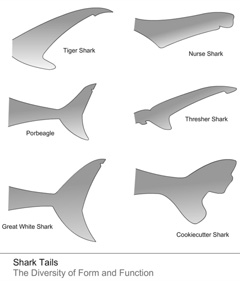|

Sizes and Scales: A mature tiger shark can average 3.25-4.25 meters (10-14 feet) long and weigh 325-425 kilograms (850-1400 pounds). It is found in many tropical and temperate regions of the worlds oceans, and is especially common around islands in the central Pacific.
 On the Menu: The tiger shark is a dangerous predator, known for eating a remarkably
wide variety of things. Its usual diet consists of fish, seals,
birds, smaller sharks, squid and turtles. It has sometimes been
found with detritus such as license plates or pieces of old tires
in its digestive tract. The Tiger shark is notorious for attacks
on swimmers, divers and surfers in Hawaii; it is often referred
to as the "bane of Hawaiian surfers". On the Menu: The tiger shark is a dangerous predator, known for eating a remarkably
wide variety of things. Its usual diet consists of fish, seals,
birds, smaller sharks, squid and turtles. It has sometimes been
found with detritus such as license plates or pieces of old tires
in its digestive tract. The Tiger shark is notorious for attacks
on swimmers, divers and surfers in Hawaii; it is often referred
to as the "bane of Hawaiian surfers".
Fierce Fish: The tiger shark is second only to the Great White in number of
recorded human fatalities and is considered, along with the Great
White, Bull Shark and the Oceanic Whitetip Shark to be one of the
most dangerous to humans.
Stunning Shark: Its skin can typically range from a blue or green hue to light
with a white or light yellow underbelly. The distinguishing dark
spots and stripes are most outstanding in young sharks and fade
as the shark matures. A tiger shark may weigh up to one ton (2,200
lb). It is usually three to five meters long (ten to sixteen feet),
but some specimens have been up to seven meters long (twenty-three
feet).
Just the Facts: Sexual maturity is reached at different stages for the sexes;
males at 2.26 to 2.9 meters (7 to 9 feet) whereas females become
mature at 2.5 to 3.25 meters (8 to 10 feet). It has been estimated
that the tiger shark can swim at a maximum speed of around 32 km/h
(20 mph), with short bursts of higher speeds that last only a few
seconds.
 Heads & Tails: The tiger shark's head is somewhat wedge-shaped, which makes it
easy for the shark to turn quickly to one side. Tiger sharks have
small pits on the side of their upper bodies which hold electrical
sensors that enable them to pick up small muscle movements of other
creatures, allowing them to hunt in darkness. Heads & Tails: The tiger shark's head is somewhat wedge-shaped, which makes it
easy for the shark to turn quickly to one side. Tiger sharks have
small pits on the side of their upper bodies which hold electrical
sensors that enable them to pick up small muscle movements of other
creatures, allowing them to hunt in darkness.
A Tiger shark generally
has long fins and a long upper tail; the long fins act like wings
and provide lift as the shark maneuvers through water, whereas the
long tail provides bursts of speed. A tiger shark normally swims
using lithe movements of its body. Its high back and dorsal fin
act as a pivot, allowing it to spin quickly on its alliance.
Teeth for Turtles: Its teeth are flat, triangular, notched and serrated. Like most
sharks, when a tiger shark loses or breaks one of its teeth, it
grows a replacement tooth. The distinctive teeth seem to have evolved
to be able to cut through turtle shells, and an adult tiger shark
can easily bite through bone.
They Hunt at Night: The tiger shark, which generally hunts at night, has a reputation
for eating anything it has access to, ignoring what nutritional
value the prey may or may not hold. Apart from what is thought to
be sparodic feeding, its most common foods include common fish,
squid, birds, seals, other sharks, and sea turtles. The shark has
a number of features which make it a good hunter, such as excellent
eyesight, which allows for access to murkier waters which can offer
varieties of prey and its acute sense of smell which enable it to
react to faint traces of blood in its waters and is able to follow
them to the source. The tiger sharks ability to pick up on low-frequency
pressure waves produced by the movements of swimming animals, in
a usual case, the thrashing of an injured animal, enables the shark
to be introduced to a variety of prey.

Birds and Bees: The tiger shark breeds by internal fertilization. Like mammals,
they give birth to live young. The male tiger shark will insert
one of its pelvic fins into the females genital opening, acting
as a guide for the sperm to be introduced. The male has been known
to use its teeth to hold the female still during the procedure,
often causing the female considerable discomfort. Mating in the
northern hemisphere will generally take place between the months
of March and May, with the young being born around April or June
the following year. In the southern hemisphere, mating takes place
in November, December, or early January.
The young are nourished inside the female body. This developmental
period can go on for 9 to 16 months, where the female can spawn
a litter ranging from 10 to 80 young. A new born tiger shark is
generally 51 to 76 cm long and usually leaves its mother upon birth,
since it has a full set of teeth and can hunt. It is unknown how
long tiger sharks live, but has been speculated it is 20 years.
All text is available under the terms
of the GNU Free Documentation License
|